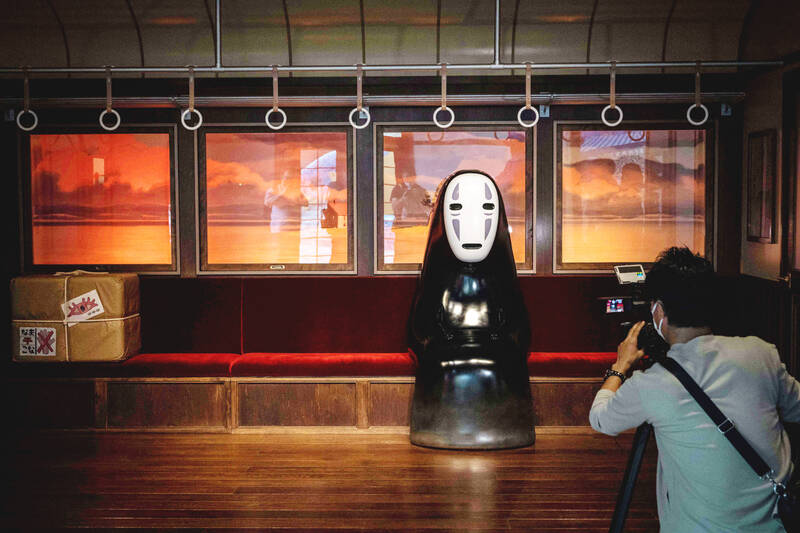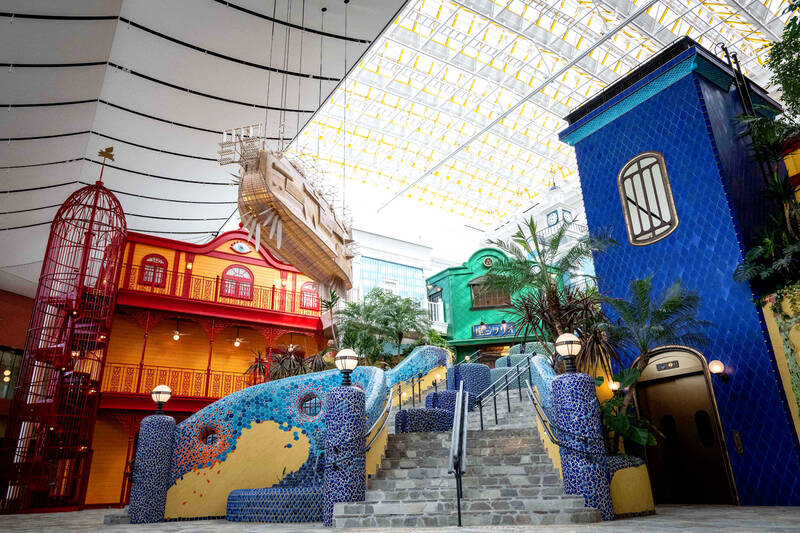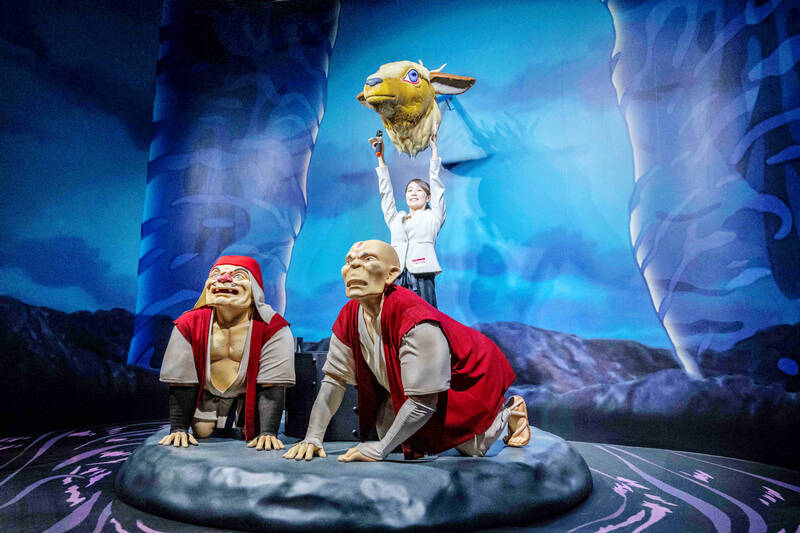Beyond the gates, a whimsical world awaits, complete with a fluffy Cat Bus, the toothy grin of Totoro and a life-sized No-Face seated on a train: welcome to Ghibli Park.
On Wednesday, media got a sneak peek at the highly anticipated new theme park from Studio Ghibli, creator of beloved titles like My Neighbor Totoro and Oscar-winning Spirited Away.
Ghibli Park will open its doors to visitors on Nov. 1, though only three of the five sections of the site in central Japan’s Aichi region will be accessible at first.

Photo: AFP
Spread over 7.1 hectares of the 194-hectare park where Aichi hosted the 2005 International Expo, the attraction features large open-air areas in keeping with the importance of nature and the outdoors in Ghibli works.
Unlike similar tourist draws such as Tokyo Disneyland, creators of the park have said it is designed to minimize fantasy and reflect the realism of Ghibli’s works.
Among the three areas that will open next month is the “Hill of Youth,” the gateway to the park and featuring an elevator tower inspired by several Ghibli films including “Castle in the Sky” and “Howl’s Moving Castle.”

Photo: AFP
Elsewhere, “Dondoko Forest” evokes the retro peace of My Neighbor Totoro, with bucolic walking paths, playground equipment, and an enormous Totoro figure.
A major draw will be the Ghibli’s Grand Warehouse, the hangar-like indoor portion of the park with various attractions, including 14 sets from 13 Ghibli classics.
Visitors can stroll along an alley designed to look like the opening scene of Spirited Away, or perch on the red velvet-covered train seat in a carriage next to the movie’s instantly recognizable “No-Face” character.

Photos: AFP
Built at a cost of 34 billion yen (US$232 million), the park is expected to become a major tourist draw for Aichi.
The region forecasts an influx of 1.8 million visitors a year once all five areas of the park are open, from next year, with an annual economic impact of an estimated 48 billion yen.
‘WE DIDN’T WANT PEOPLE TO FORGET’
Governor Hideaki Omura said Wednesday it had taken “five years and five months” to complete it, praising Studio Ghibli as “the summit” of Japanese culture.
Studio Ghibli was founded in 1985 by animators Isao Takahata and Hayao Miyazaki, and has captivated fans around the world with works blending nostalgia, courage, greed and interaction with the natural world.
Miyazaki’s son Goro told reporters Wednesday that the park was originally conceived as a way to leave Studio Ghibli’s works to future generations, in anticipation of his father’s expected retirement.
“We didn’t want people to forget Ghibli’s works,” he said. “But we were betrayed again,” he added with a laugh. “He’s making a feature film now!”
He said the theme park had been designed to have “minimal impact” on surrounding nature, with instructions that “trees shouldn’t be cut down or changes made to the environment”.
Tickets will be reservation only, costing between 1,000 to 2,500 yen per area for adults.
Studio Ghibli already operates the hugely popular Ghibli Museum on the outskirts of Tokyo, which offers tickets only at the beginning of each month, regularly selling out within hours.
Japan is home to several major theme parks, including Tokyo Disneyland and Universal Studios in Osaka.
After two-and-a-half years of tough COVID restrictions, the borders yesterday reopened fully to tourists, and a massive influx of foreign visitors is expected in coming months.

One of the biggest sore spots in Taiwan’s historical friendship with the US came in 1979 when US president Jimmy Carter broke off formal diplomatic relations with Taiwan’s Republic of China (ROC) government so that the US could establish relations with the People’s Republic of China (PRC). Taiwan’s derecognition came purely at China’s insistence, and the US took the deal. Retired American diplomat John Tkacik, who for almost decade surrounding that schism, from 1974 to 1982, worked in embassies in Taipei and Beijing and at the Taiwan Desk in Washington DC, recently argued in the Taipei Times that “President Carter’s derecognition

This year will go down in the history books. Taiwan faces enormous turmoil and uncertainty in the coming months. Which political parties are in a good position to handle big changes? All of the main parties are beset with challenges. Taking stock, this column examined the Taiwan People’s Party (TPP) (“Huang Kuo-chang’s choking the life out of the TPP,” May 28, page 12), the Democratic Progressive Party (DPP) (“Challenges amid choppy waters for the DPP,” June 14, page 12) and the Chinese Nationalist Party (KMT) (“KMT struggles to seize opportunities as ‘interesting times’ loom,” June 20, page 11). Times like these can

June 23 to June 29 After capturing the walled city of Hsinchu on June 22, 1895, the Japanese hoped to quickly push south and seize control of Taiwan’s entire west coast — but their advance was stalled for more than a month. Not only did local Hakka fighters continue to cause them headaches, resistance forces even attempted to retake the city three times. “We had planned to occupy Anping (Tainan) and Takao (Kaohsiung) as soon as possible, but ever since we took Hsinchu, nearby bandits proclaiming to be ‘righteous people’ (義民) have been destroying train tracks and electrical cables, and gathering in villages

Dr. Y. Tony Yang, Associate Dean of Health Policy and Population Science at George Washington University, argued last week in a piece for the Taipei Times about former president Ma Ying-jeou (馬英九) leading a student delegation to the People’s Republic of China (PRC) that, “The real question is not whether Ma’s visit helps or hurts Taiwan — it is why Taiwan lacks a sophisticated, multi-track approach to one of the most complex geopolitical relationships in the world” (“Ma’s Visit, DPP’s Blind Spot,” June 18, page 8). Yang contends that the Democratic Progressive Party (DPP) has a blind spot: “By treating any